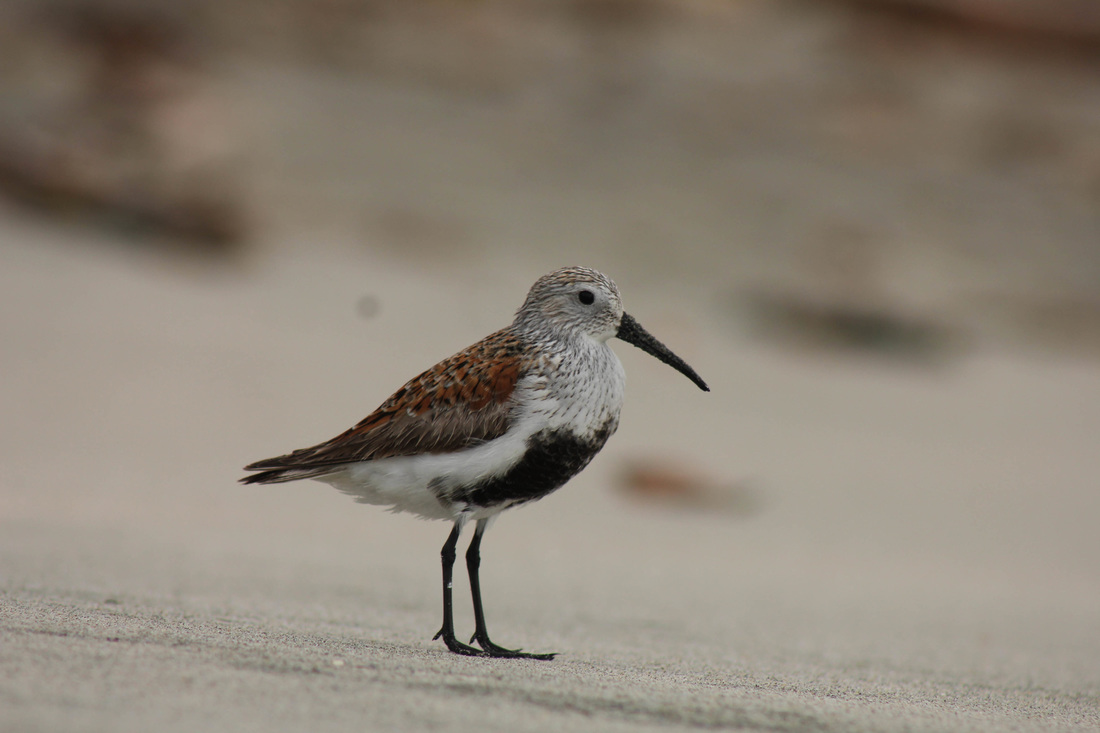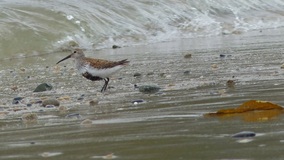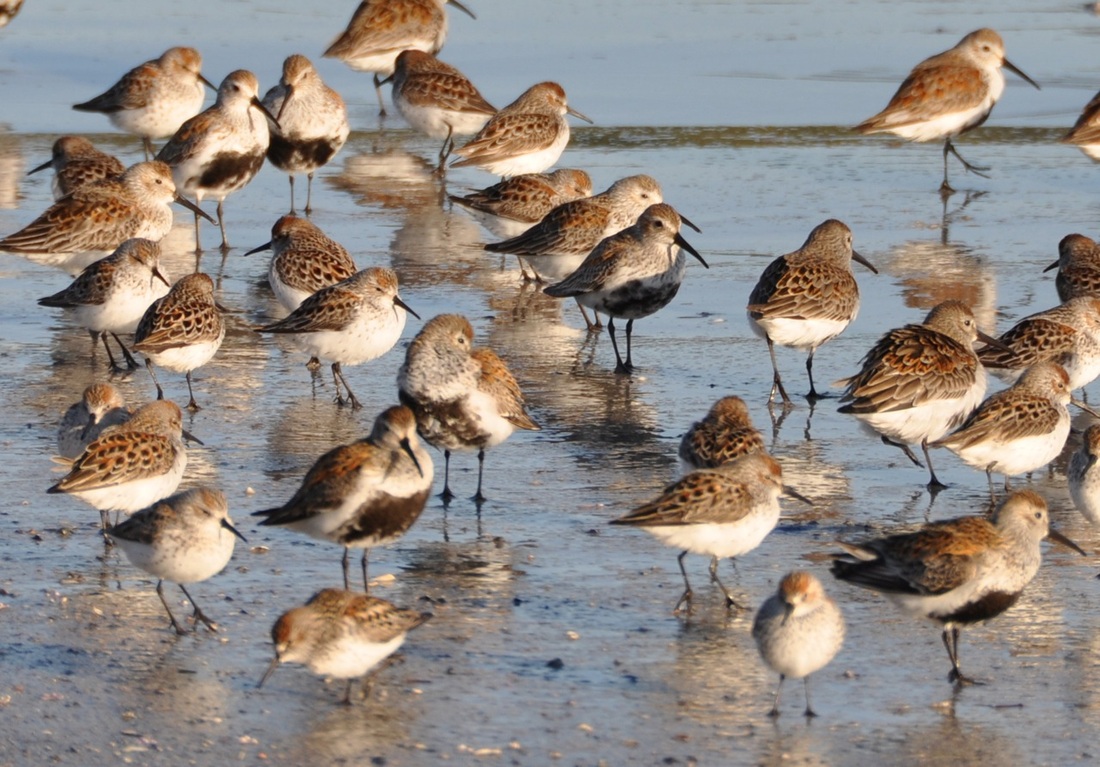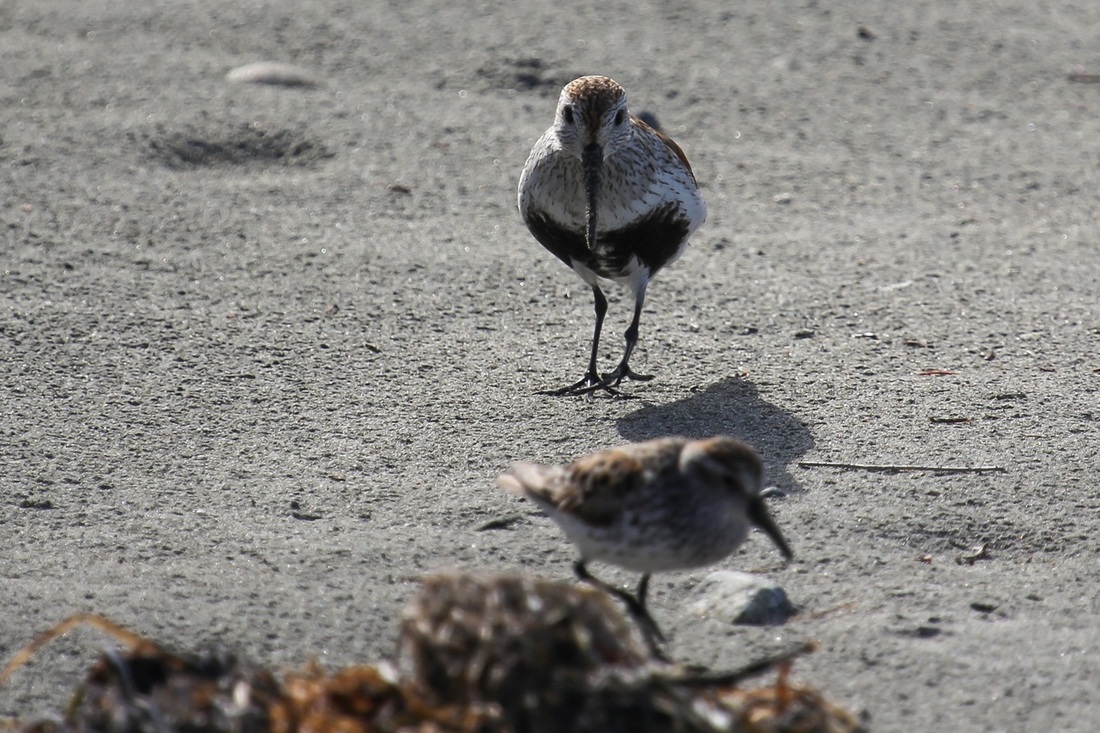Dunlin • Calidris alpina
|
Photos by, from bottom left: Kira Hoffman, Brian Starzomski, Ian Thomas, and Josh Silberg, Bottom left: dunlin with western sandpipers (Calidris mauri). The dunlin are in breeding plumage, and so can be easily distinguished by the large dark spots on their chests. They are also larger than the sandpipers and have longer, drooping bills.
|
Identification
This medium-sized shorebird has a relatively long, drooping black bill and long black legs. It has a relatively shore neck and a somewhat hunched appearance. Its breeding plumage is distinctive, with a large black belly spot, reddish cap, and reddish back. Its non-breeding plumage, which consists of a white belly and brownish-grey back, is less helpful for identification purposes.
Habitat & Range
Dunlin nest in wet coastal tundra and spend the winter along mudflats, estuaries, marshes, flooded fields, sandy beaches, and along lakeshores and rivers. They winter along the Central Coast of BC, through some may appear in the area in breeding plumage if migrating further south. Their winter range extends along the east and west coasts of North America. They can be found throughout much of North America during migration. Populations are also found in Eurasia.
Similar Species
Sanderlings (Calidris alba) are a similar size and have a black bill and black legs. However breeding adults are obviously different with red heads and breasts, while nonbreeding adults are much paler than nonbreeding dunlin. Rock sandpipers (Calidris ptilocnemis) have a black breast spot (higher up than the belly spot of dunlins) and yellow legs.
Intriguing Info
Ritualized nest-making plays a role in dunlin courtship. Both the male and female making ground ‘scrapes’ and lining them with foliage; the female then chooses a scrape and turns it into a finished nest.
This medium-sized shorebird has a relatively long, drooping black bill and long black legs. It has a relatively shore neck and a somewhat hunched appearance. Its breeding plumage is distinctive, with a large black belly spot, reddish cap, and reddish back. Its non-breeding plumage, which consists of a white belly and brownish-grey back, is less helpful for identification purposes.
Habitat & Range
Dunlin nest in wet coastal tundra and spend the winter along mudflats, estuaries, marshes, flooded fields, sandy beaches, and along lakeshores and rivers. They winter along the Central Coast of BC, through some may appear in the area in breeding plumage if migrating further south. Their winter range extends along the east and west coasts of North America. They can be found throughout much of North America during migration. Populations are also found in Eurasia.
Similar Species
Sanderlings (Calidris alba) are a similar size and have a black bill and black legs. However breeding adults are obviously different with red heads and breasts, while nonbreeding adults are much paler than nonbreeding dunlin. Rock sandpipers (Calidris ptilocnemis) have a black breast spot (higher up than the belly spot of dunlins) and yellow legs.
Intriguing Info
Ritualized nest-making plays a role in dunlin courtship. Both the male and female making ground ‘scrapes’ and lining them with foliage; the female then chooses a scrape and turns it into a finished nest.
References
Dunlin (Calidris alpina). ARKive.org. Accessed 18/08/2014.
Dunlin (Calidris alpina). Audubon Birds. National Audubon Society. Accessed 29/04/2014.
Dunn, J. L. and Alderfer, J. (Eds.). (1999). National Geographic Field Guide to the Birds of North America. (3rd Ed.). Washington, D.C.: National Geographic Society. Pp. 172-173.
Dunlin (Calidris alpina). The Birds of North America Online (A. Poole, Ed.). Ithaca: Cornell Lab of Ornithology. Retrieved from the Birds of North America Online. Accessed 18/08/2014.
Authors and editors of page
Kelly Fretwell and Brian Starzomski (2014).
Dunlin (Calidris alpina). ARKive.org. Accessed 18/08/2014.
Dunlin (Calidris alpina). Audubon Birds. National Audubon Society. Accessed 29/04/2014.
Dunn, J. L. and Alderfer, J. (Eds.). (1999). National Geographic Field Guide to the Birds of North America. (3rd Ed.). Washington, D.C.: National Geographic Society. Pp. 172-173.
Dunlin (Calidris alpina). The Birds of North America Online (A. Poole, Ed.). Ithaca: Cornell Lab of Ornithology. Retrieved from the Birds of North America Online. Accessed 18/08/2014.
Authors and editors of page
Kelly Fretwell and Brian Starzomski (2014).







